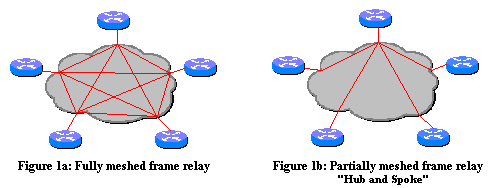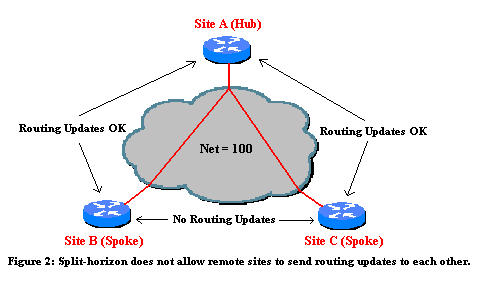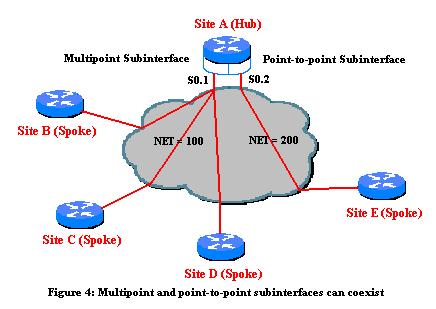

Understanding Frame Relay Subinterfaces
Subinterfaces provide a flexible solution for routing various protocols over partially-meshed frame relay networks (Figure 1b). A single, physical interface can be logically divided into multiple, virtual subinterfaces. The subinterface may be defined as either a point-to-point connection or a multipoint connection.

Point-To-Point Subinterfaces
The concept of subinterfaces was originally created in order to better handle issues caused by split-horizon over Non-Broadcast Multiple Access (NBMA) networks (e.g. frame relay, X.25) and distance-vector based routing protocols (e.g. IPX RIP/SAP, AppleTalk). Split-horizon dictates that a routing update received on an interface cannot be retransmitted out onto the same interface. This rule holds even if the routing update was received on one frame relay PVC and destined to retransmit out onto another frame relay PVC. Referring to figure 2, this would mean that sites B and C can exchange routing information with site A, but would not be able to exchange routing information with each other. Split-horizon does not allow Site A to send routing updates received from Site B on to Site C and vice versa.
Note: For TCP/IP, Cisco routers can disable split-horizon limitations on all frame relay interfaces and multipoint subinterfaces and do this by default. However, split-horizon cannot be disabled for other protocols like IPX and AppleTalk. These other protocols must use subinterfaces if dynamic routing is desired.

By dividing the partially-meshed frame relay network into a number of virtual, point-to-point networks using subinterfaces, the split-horizon problem can be overcome. Each new point-to-point subnetwork is assigned its own network number. To the routed protocol, each subnetwork now appears to be located on separate interfaces (Figure 3). Routing updates received from Site B on one logical point-to-point subinterface can be forwarded to site C on a separate logical interface without violating split horizon.

Multipoint Subinterfaces
Cisco serial interfaces are multipoint interfaces by default unless specified as a point-to-point subinterface. Though less common than point-to-point subinterfaces, it is possible to divide the interface into separate virtual multipoint subinterfaces.
Multipoint interfaces/subinterfaces are still subject to the split-horizon limitations as discussed above. All nodes attached to a multipoint subinterface belong to the same network number. Typically, multipoint subinterfaces are used in conjunction with point-to-point interfaces in cases where an existing multipoint frame relay cloud is migrating to a subinterfaced point-to-point network design. A multipoint subinterface is used to keep remote sites on a single network number while slowly migrating remote sites to their own point-to-point subinterface network.
Figure 4 shows serial 0.1 as a multipoint subinterface connecting to three different locations. All devices on the multipoint subinterface belong to the same network number (100). Site E has migrated off of the multipoint network to its own point-to-point subinterface network (200). Eventually, all remote sites can be moved to their own point-to-point subinterface networks and the multipoint subinterface will not be necessary.

All contents copyright © 1992--1999 Cisco Systems, Inc. Important Notices and Privacy Statement.